OK, so it’s probably not always the ‘best chub rig in the world ever’ but in these days of hyperbole it seemed as good a way as any of kicking off this feature and, to be fair, it is a rig which has accounted for dozens of chub over 6lb for me in the past few seasons and probably getting on for a hundred or so in all the years I have used it. I’m not for a moment saying I wouldn’t have caught a lot of those fish by other means but I’m certain that on a lot of venues, and with a lot of fish, it has given me a genuine edge.
So, what is it and why is it so good? Let’s start at the beginning, where else, and look at chub baits.
I have to say the bait I have caught most of my big chub on over the years is milk protein but that is probably because it is the bait I fish most often and it is perfectly suited to the pre-baiting followed by very short session fishing that I tend to do.
Chub, however, are the ultimate omnivores, they will eat just about anything, but the one bait which stands head and shoulders above all of the others is the humble maggot.
Providing you have a little time, and indeed patience, to feed a swim then there is no chub that swims which you will not catch as they just cannot help themselves and, rather like a kid in a sweetshop, no matter how much they know they shouldn’t they just can’t help themselves – and once they start they just cannot stop.
Spraying maggots and trotting over the top is one way to take advantage of this greed and it works both shallow, under a waggler, or deeper, under a stick float, Avon or loafer but for me the ‘clinical’ and most efficient way to trap them is with the maggot feeder.
Unlike barbel, which will usually stay well back from a feeder and wait for the feed to be carried downstream to them, the greed of chub is such that once the flow of feed has been established they will be on the feeder as soon as it splashes down, looking to get at the maggots as quickly as possible and before their shoal mates. This results in a lot of bangs and knocks on the tip as the fish knock and quite literally pick up the feeder to get to the maggots as quickly as possible; often resulting in missed ‘bites’.
I tend to start a session by fishing without a hooklength; simply filling up a feeder and re-casting it to the head of the swim every couple of minutes to get a steady trickle of feed through the corridor. Quite how long this initial feeding takes is dictated entirely by the fish activity. What I’m looking for is constant ‘bangs’ on the quiver tip as the fish attack it – I don’t mean the odd ‘tap’ either – I mean a constantly moving tip with it occasionally pulling right round as a chub lifts the feeder right off the deck and tries to do a runner with it.
I’ve known this initial process to take anything from a few minutes to a few hours depending on the nature of the swim, the density of chub on the beat, how pressured the fish are, when they were last fished for, conditions on the day…. Every day is different and indeed on many days and in many swims it is not always the best approach to try but given a long, relatively featureless glide and a touch of water clarity on a river with a decent head of big chub then I find it hard to beat.
With the fish worked into a frenzy it’s easy to pick off a couple fairly quickly, especially the smaller fish in the 3 to 5lb range but to consistently nail the larger fish effectively you need to employ very fine tackle and very short hooklengths with a size 18 or 20 hook to an inch or two of 2lb line about right for the rivers I fish and the chub I tend to target.
To many people this will seem ridiculous light but believe me it makes a massive difference to your results; I would guesstimate that each time you go up a hook size and line diameter you probably halve the number of bites you get…
Of course it’s not the kit you want to be using when trying to extract a fish from a jungle of underwater roots – then it’s time for the 6lb line, 4lb hooklength and size 10 but in an ‘open’ swim with a soft rod it’s just a matter of taking your time.
The problem with such tackle is that such a short hooklength in close proximity to the feeder can result in line breaks and hook pulls and it is none too easy playing a big Chevin safely when your feeder is bumping against its nose throughout the fight.
To overcome this I devised (well, I say ‘I’ devised it – someone may well have come up with it before me but if so I hadn’t seen it before!) the following rig which allows you to fish a ‘standard’ length hooklength but to present it in such a way that your hookbait sits perfectly on top of the feeder, as if there was no hooklength at all, and yet as soon as the fish is hooked the full length of the hooklength comes into play. It also has the advantage that anyone watching you play and land the fish gets the impresssion you are using a bog standard set up – and that works for me too!
A rubber maggot is the perfect hookbait as they eliminate the possibility of small fish pecking away at the bait and indeed hooking themselves, although I’m sure a big chub would take a minnow anchored to the top of a maggot feeder it’s not ideal! A rubber grub keeps it neat and sweet.
Here’s how I make it:
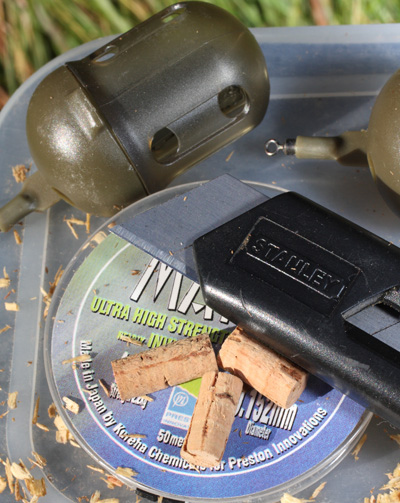 Step 1
Step 1
The first step is simply to shave a cork plug so it fits tightly inside one of the holes in your choice of maggot feeder.
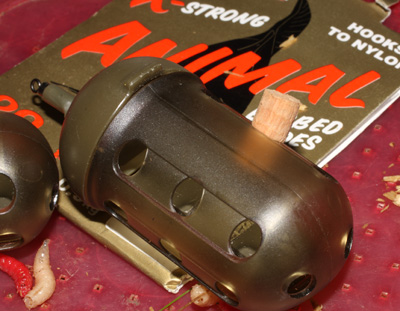 Step 2
Step 2
Once you have the fit push the plug into one of the holes – opposite the weighted side so it will always sit on top of the feeder – and cut a slice through the plug into which you can then insert your baited hook.
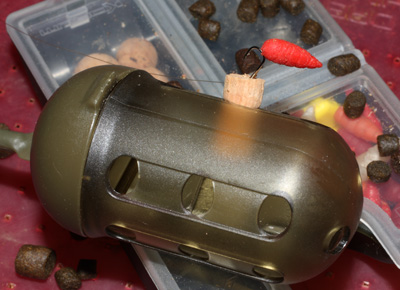 Step 3
Step 3
The finished rig looks like this.
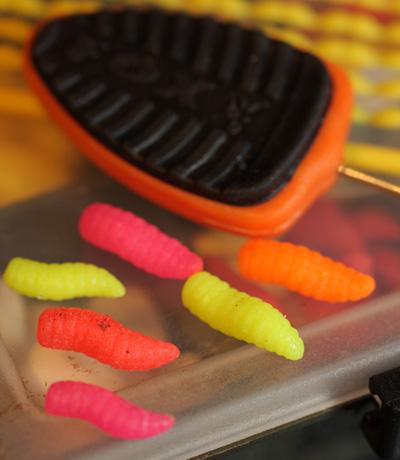 Step 4
Step 4
I tend to fish red maggots if the water is clear and white maggots if there is a bit of colour to it but I’ve experimented with fluorescent grubs too and they work every bit as well, and may indeed offer an edge at times.
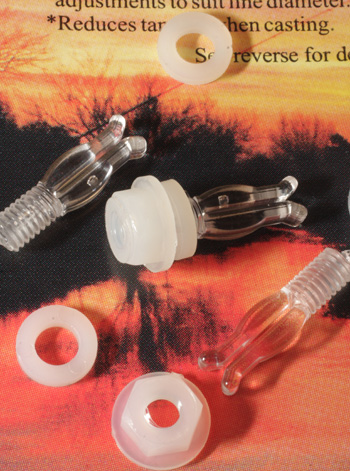 Step 5
Step 5
To make the whole process a lot easier, and indeed more versatile, I’ve literally just discovered that Enterprise Tackle manufacture a swimfeeder line clip that simply screws into your feeder and allows you to tension the clip perfectly according to the diameter of line you are using. I’ve not tried one yet but it looks like a real winner.










